Schede a microprocessore/controllore
|
usate dal LPE per lo sviluppo di applicazioni Embedded e Robotica
|
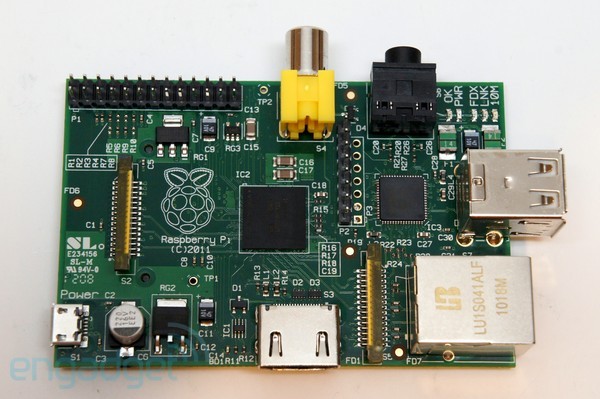 |
Raspberry PI sbc
ARM1176JZFS processor with FPU and Videocore 4 GPU
GPU provides Open GL ES 2.0, hardware-accelerated OpenVG,
and 1080p30 H.264 high-profile decode
GPU is capable of 1Gpixel/s, 1.5Gtexel/s or 24GFLOPs
with texture filtering and DMA infrastructure, 256MB RAM
Boots from SD card, running the Fedora version of Linux
HDMI socket, USB 2.0 socket, RCA video socket, SD card socket
Powered from microUSB socket, 3.5mm audio out jack
Header footprint for camera connection
|
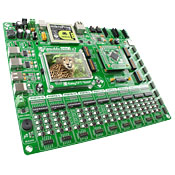 |
EasyMx PRO v7 for STM32 ARM® is a development board for
STM32 ARM® Cortex™-M3 and Cortex™-M4 devices.
It contains many on-board modules necessary for device
development, including multimedia, Ethernet, USB, CAN and other.
|
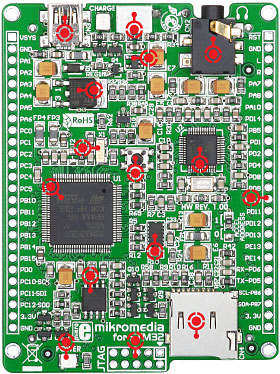 |
mikromedia for STM32 M3
This board provides a compact high-quality multimedia development
platform for STM32F207VGT6 device. It has numerous on-board
modules, that allow you to write multimedia applications.
This board can be used for both development or as a final product.
|
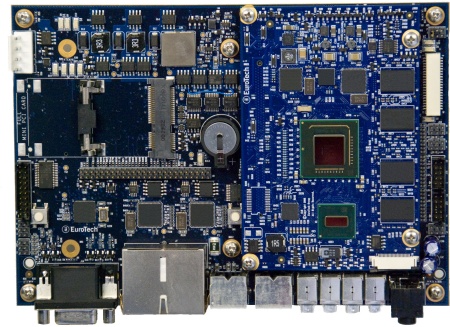 |
The Catalyst EC, based on the Intel Atom processor, offers high performance with under 3W of power consumption and very low heat generation. Targeted for mobile applications such as transportation, medical and industrial where low power and fanless operation are critical, the Catalyst EC consists of an EPIC-compliant carrier board with Eurotech's Catalyst Module mounted to it.
|
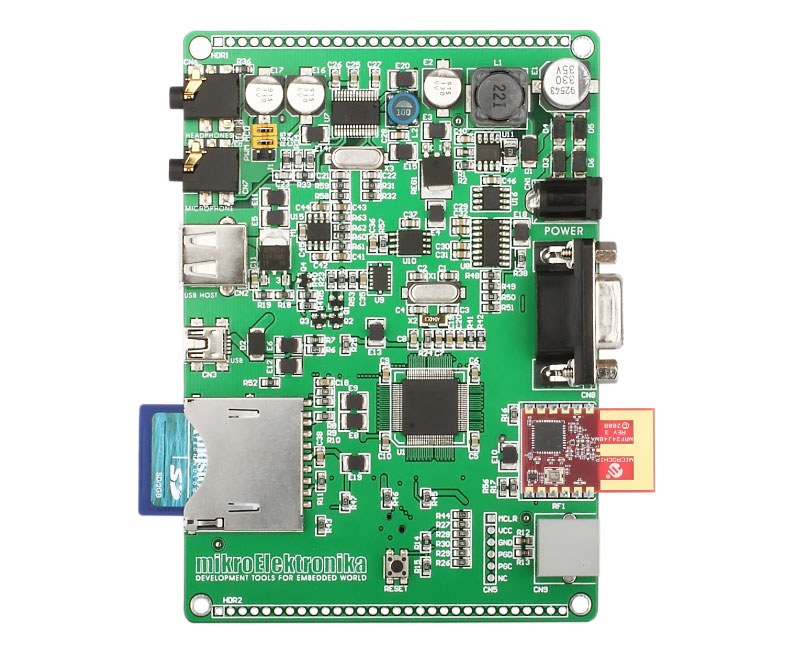 |
This board provides a complete, high-quality multimedia development platform for PIC32MX4 devices. It has numerous on-board modules, that allow you to write multimedia application of high complexity. This board can be used for both development or as a final product.
|
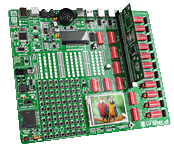 |
LV-32MX v6 is a full-featured PIC32 development system equipped with many on-board modules, including multimedia peripherals which give you great power and flexibility when creating or testing your prototype. Board comes with MCU Card carrying PIC32MX460F512L microcontroller.
|
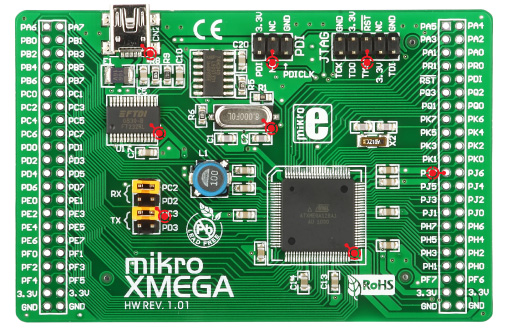 |
mikroXMEGA Board is a complete solution for fast and simple development of embedded applications using new Atmel® ATxmega128A1 device connected to 8Mhz oscillator.
|
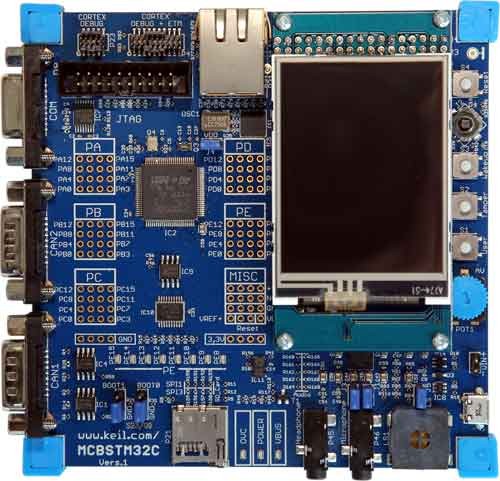 |
The Keil MCBSTM32C Evaluation Board introduces the new STM32 Connectivity family of ARM Cortex-M3 processor-based devices, allowing you to create and test working programs for this advanced architecture.
The MCBSTM32C has a wide range of interfaces making it a great starting point for your next Cortex-M3 project.
|
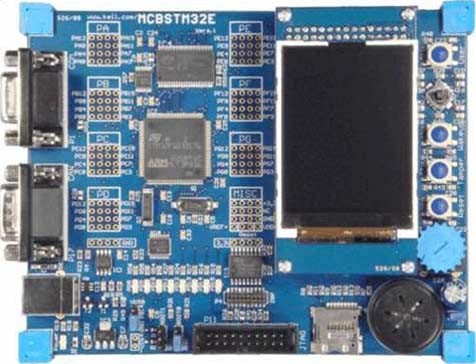 |
The Keil MCBSTM32E Evaluation Board introduces you to the STMicroelectronics Cortex-M3 family of ARM devices and allows you to create and test working programs for this advanced architecture.
Featuring a QVGA LCD display plus a wide range of interfaces such as USB, CAN, MicroSD Card and UART, the MCBSTM32E is a great starting point for your Cortex-M3 project
|
 |
The Keil MCB2100 Evaluation Board introduces you to the NXP (founded by Philips) LPC2129 family of ARM processor-based devices. The MCB2100 allows you to quickly create and test programs for this advanced architecture.
The Keil MCB2100 Evaluation Board connects to your PC using the serial port (for Flash download using FlashMagic) or the JTAG interface (for program debug using a Keil ULINK family USB-JTAG Adapter and the µVision IDE and Debugger).
Two Serial and two CAN interfaces make this board a great starting point for your
|
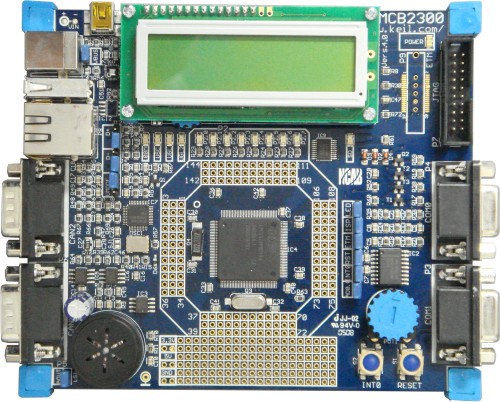 |
The Keil MCB2300 Evaluation Board introduces you to the NXP (founded by Philips) LPC2300 ARM family and allows you to create and test working programs for this advanced architecture.
Two serial interfaces, a speaker, analog input (via potentiometer), two CAN interfaces, LCD, USB, Ethernet, and eight LEDs make this board a great starting point for your next ARM project.
|
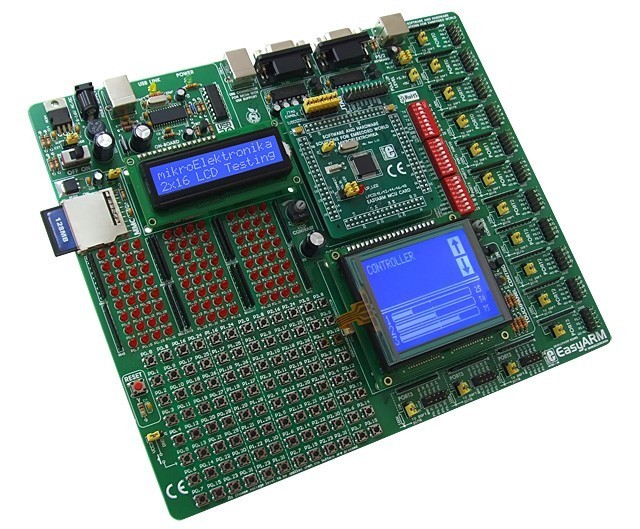 |
EasyARM supports a wide range of 64- and 144-pin ARM (NXP LPC Family) MCUs.
Very fast, on-board USB 2.0 programmer with a simplified driver installation.
MMC/SD cards enable you to add mass storage support to your prototype devices.
EasyARM allows ARM microcontrollers to be interfaced with numerous peripheral devices.
PS/2 communication with external devices is established via the on-board PS/2 connector.
EasyARM includes an on-board Touch Screen Controller with Touch Panel connector
|
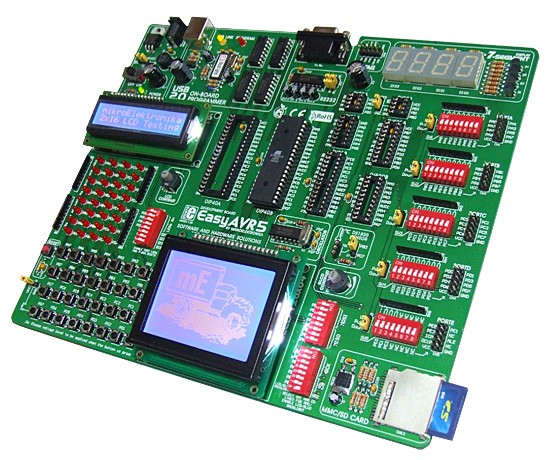 |
EasyAVR5 supports 8, 14, 20, 28 and 40 pin microcontrollers (it comes with ATMEGA16). Each jumper, element and pin is clearly marked on the board. High-Performance USB 2.0 On-Board Programmer
State-Of-The-Art very fast USB 2.0 programmer on-board with simplified driver installation User-Friendly Atmel AVR development system
EasyAVR5 development system is a full-featured development board for the Atmel AVR microcontrollers. EasyAVR5 is easy to use Atmel AVR development system. EasyAVR5 has many features that makes your development easy. You can choose between USB or External Power supply. EasyAVR5 also supports Character LCD as well as Graphic LCD.
|
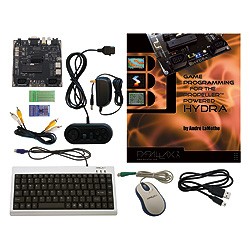 |
HYDRA Game Development Kit
Develop games, graphics and media applications with the Propeller Powered HYDRA Game Console. For beginner to intermediate coders, you need only basic programming experience in any BASIC or C-like language. All of the hardware and software you need is included (as shown in pictures), along with the comprehensive book on game programming for the Propeller in Spin and assembly language - "Game Programming for the Propeller Powered HYDRA". Within the book, the HYDRA hardware is covered in detail with schematics, descriptions, and tips allowing you to take full advantage of its resources, including its expansion port and game card
|
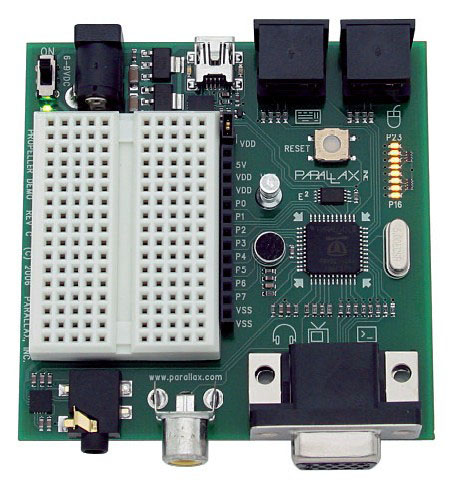 |
The Parallax P8X32 Propeller, introduced in 2006, is a multi-core architecture parallel microcontroller with eight 32-bit RISC CPU cores.
The Parallax Propeller microcontroller, Propeller Assembly language, and Spin interpreter were designed by one person, Parallax's co-founder and president Chip Gracey. The Spin Programming language and "Propeller Tool" integrated development environment were designed by Chip Gracey and Parallax's software engineer Jeff Martin. The Propeller is known for being easy to program.
Multi-core architecture
Each of the eight 32-bit cores (called a cog) has an elementary CPU (the ALU of which does not directly support division) and access to 512 32-bit long words (2 KB) of instructions and data. Self-modifying code is possible and is used internally, for example by an instruction that is used to create a subroutine call/return mechanism without the need for a stack. Access to shared memory (32 KB RAM; 32 KB ROM) is controlled in round-robin fashion by an internal bus controller called the hub. Each cog also has access to two dedicated hardware counters and two special "video registers" for use in generating PAL, NTSC, VGA, servo-control, or other timing signals
|
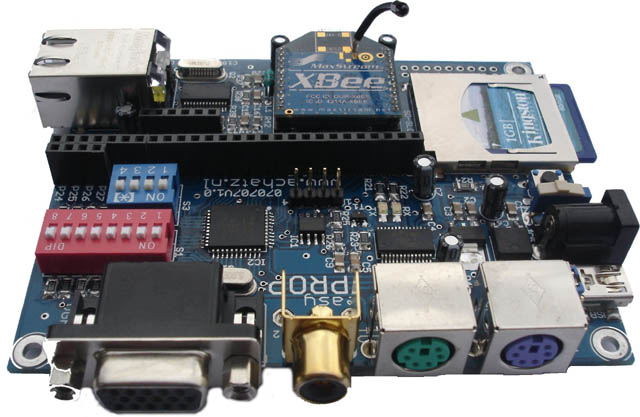 |
easyProp Feature List
Propeller Chip with ext. XTAL 5 MHZ
I2C EEPROM
Audio
SD Memory Slot
USB Programming Interface
Ethernet ENC28J60 Interface
XBee Module (optional)
Power via USB
Power via Barrel Connector (6 ...9 VDC)
VGA
TV Video
PS2 Mouse Interface
PS2 Keyboard Interface
Port Pins P0...P27 available via SIL Pinheader
Reset Switch
User LEDs for P22 and P23
VGA and Video can be disabled via the DIL Switches
|
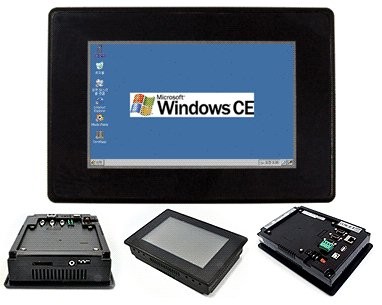 |
The CUWIN3500 combines a graphic display and touch interface with a high efficiency industrial controller.
It is equipped with Microsoft Windows CE 5.0 Embedded, a stable operating system used in many industrial touchscreen applications. Windows CE supports applications developed in Microsoft Visual Studio 2005 and other development tools able to create Windows CE ARM executables. It can also run NSBasic scripts.
Developing for the CUWIN is similar to normal PC program development; anyone with previous PC programming experience can develop CUWIN applications without difficulty. The CUWIN supports the .NET Compact Framework (1.0, 2.0) which reduces development and testing time by allowing the use of cross-platform .NET functions.
The CUWIN can also operate in IntelliLCD Mode, which allows the CUWIN to emulate an IntelliLCD as a drop-in replacement. Existing IntelliLCD applications can upgrade to a CUWIN today, and not lose functionality while the CUWIN native applications are developed.
The CUWIN offers RS232, RS485, and Ethernet for external communication. It can even browse web sites using the internal browser, which is useful for displaying diagnostic data or even remote control panels through a web interface.
|
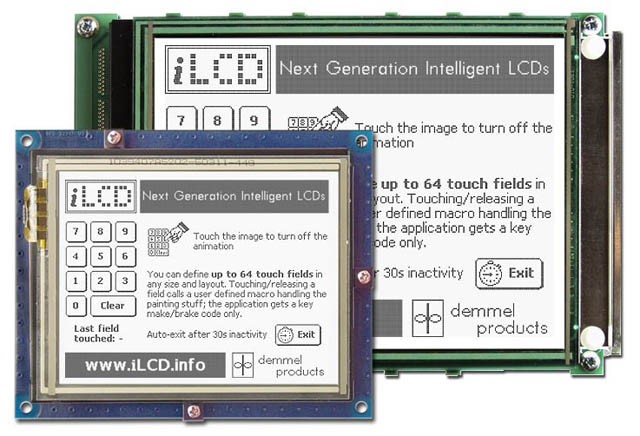 |
The fast 32-bit iLCD Controller DPC3080 and the flash memory with 32 MByte for images, text strings, fonts and macros and the RAM with 8 MByte for multiple screen handling with simple commands recommends these iLCD panels to be used with any application.
Both panels have the same functionality and are connected via a 1.0 mm pitch FFC cable, an optional interface board is available. The panels can be exchanched without any hardware modification.
An evaluation kit with extra PCB with FFC connectors and flat-cables plus all other required cables including a power-supply and software on CD is available for both panels.
|
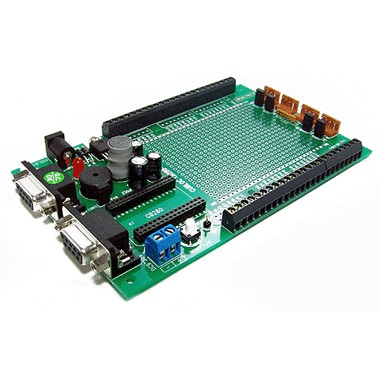  |
CUBLOC CORE MODULE
BASIC with Ladder Logic Industrial Controller
- Ideal for apps requiring large number of I/O ports.
- Ideal for apps requiring data memory back-up during power-down.Ideal for apps requiring large data memory. (e.g. Modbus RTU Master mode)
- Ideal for small to mass production (1 to 1000+), Embeddable in customized PCB
- MODBUS ASCII (Master & Slave Mode) Support
- MODBUS RTU (Master & Slave Mode) Support
- External Peripherals CuNET (I2C) included.
- External Peripherals SPI included.
- Develop using CublocStudio in BASIC and/or Ladder Logic Language.
Processor
CUBLOC CB405RT
Microprocessor
Atmega2560 @ 18.432Mhz
Program Memory (Flash)
200KB
Data Memory (RAM)
51KB(BASIC) + 4KB(Ladder Logic) + 55KB(Heap Memory)
EEPROM
4KB EEPROM
Program Speed
~36,000 instructions/sec
General Purpose I/O
58 I/O lines (5V TTL) (input/output configurable)
Serial Ports for Communication
- 4 High-speed hardware-independent serial ports
- Configurable Baud rates: 2400bps to 230,400 bps
Analog Inputs
8 channel 16-bit ADCs
Analog Outputs
- 12 Channel 16-bit PWMs (DACs)
- Configurable Frequency: 35hz to 1.5Mhz
External Interrupts
4 Channels
High Speed Counters
2 Channel 32-bit Counters (up to 2Mhz)
Power
5V, 50mA (ports unloaded)
RTC (Real Time Clock)
YES
Timers
- 1 User Configurable Timer
- Configurable Interval Units = 10ms
Data Memory Back-up
Yes, a rechargable Super-Capacitor or Battery may be required.
|
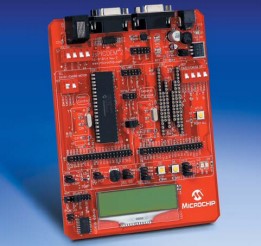 |
dsPICDEM 2 Development Board
The dsPICDEM™ 2 Development Board is a development and evaluation tool that helps create embedded applications using dsPIC30F Digital Signal Controllers. Sockets are provided for 28 and 40-pin devices in the motor control family and 18, 28 and 40-pin devices in the general purpose and sensor family.
The board includes a sample dsPIC30F4011 Digital Signal Controller in the 40-pin motor control socket, a power supply regulator, crystal oscillators for each set of sockets, an ICD connector for the MPLAB® ICD 2 In-Circuit Debugger and both RS-232 and CAN ports for external communication. In addition, the board is populated with prototyping hardware, including LED indicators, push button switches, a potentiometer, a temperature sensor and a 2x16 LCD screen. All pins on all the devices are accessible through headers
|
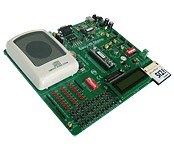 |
The Easy-VRStamp is a full-featured development system for VR Stamp voice recognition modules. It is designed to allow students and engineers to easily test and explore the capabilities of VR Stamp voice recognition modules.
|